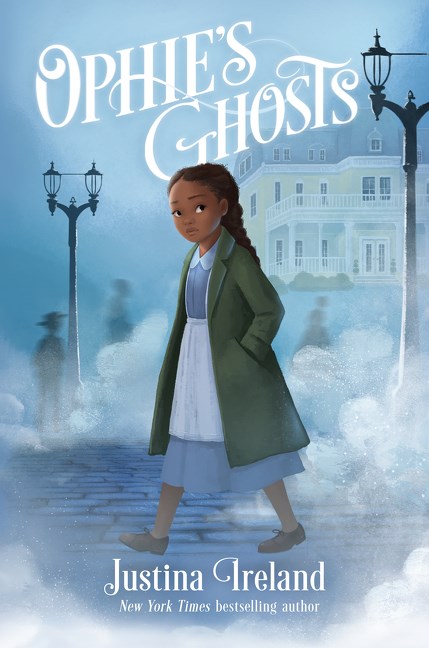Reviewed by Paige Pagan
Review Source: Teaching for Change
Book Author: Justina Ireland
Ophie’s Ghosts, winner of the Scott O’Dell Award for Historical Fiction, is a beautifully tender middle grade novel set in the 1920s about the complexity of grief and its lingering effects on both the living and the dead. Author Justina Ireland offers a thought-provoking message on what it means to be “passing white” and what happened to Black folks who sought social mobility. This narrative also raises the harsh reality of generations of Black women who were forced to work as household staff and caretakers to rich white families for lack of other jobs and as their only means of survival — a close extension of slavery.
It’s 1922 in Jim Crow Georgia when Ophie is startled awake one night by her father telling her to take the family’s life savings from underneath the floorboard, grab her mama, and run. The pair barely escape the house before a group of white men set it ablaze. That’s not the worst thing to happen that night though. Ophie learns that her father was killed by that same group of men for exercising his right to vote hours before he appeared to Ophie. In that moment, Ophie has an epiphany that she has the gift of seeing ghosts.
This catastrophic event sets in motion Ophie and her mother’s move to Pittsburgh, where old Aunt Rose opens the doors of her modest, cozy home to them. There, Ophie reluctantly drops out of school to work with Mama in Daffodil Manor so they can save up enough money to move out on their own, away from Aunt Helen and the cousins who also live with Aunt Rose and have taken to tormenting Ophie and Mama. But the lavish Daffodil Manor, owned by the brutally racist Mrs. Caruthers and her careless son, Richard, sits atop a ton of secrets, proven by the sheer amount of haints inhabiting it. Ophie has no choice but to rise to the task of caring for Mrs. Caruthers, who often refers to slavery as an idyllic pastime in Ophie’s presence. Then one day, Ophie befriends a pretty ghost named Clara who gives her pointers on how to get in Mrs. Caruthers’ good graces. Now Ophie feels obliged to help Clara unveil the mystery surrounding her murder and free her soul, not knowing that the advantage Ophie assumed Clara had for passing white might have been the reason behind her tragic end.
Through her clairvoyant protagonist, Ireland shows how one may transform grief into good works. Ophie’s dedication to helping lost souls pass on ends up bringing closure to Black families and even creates more opportunities. The subtle, yet powerful takeaway that everyone will eventually receive what they deserve is both accessible for the target audience and satisfying.
For teens and adults who are handing the tweens in your life Ophie’s Ghosts, we recommend checking out The Reformatory by Tananarive Due for yourselves!
Paige Pagan is a Social Justice Books program specialist at Teaching for Change.
Find more recommended books on this topic on our Historical Novels booklist.

Ophie's Ghosts by Justina Ireland
Published by HarperCollins Publishers on May 3, 2022
Genres: Historical Fiction
Pages: 336
Reading Level: Grades 6-8
ISBN: 9781536478167
Review Source: Teaching for Change
Publisher's Synopsis: Ophelia Harrison and her family used to live in a small house in the Georgia countryside. But that was before the night in November 1922 and the cruel act that took her home and her father from her.

Leave a Reply